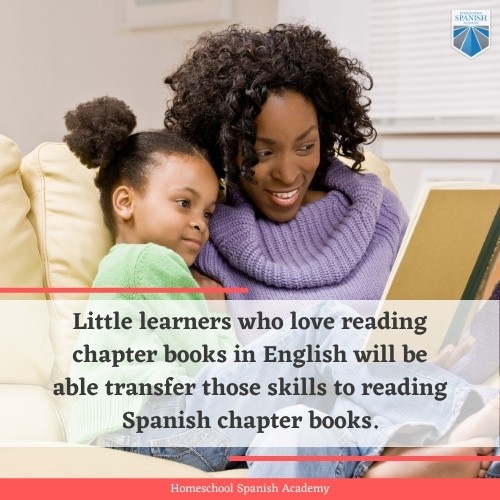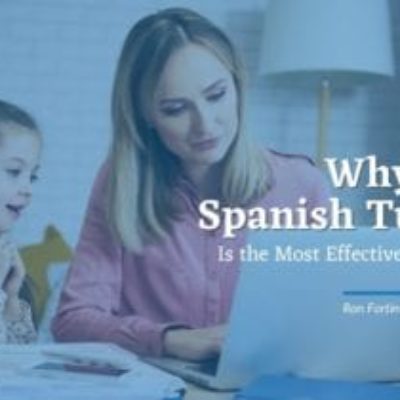
40+ Bilingual Homeschooling Resources for Your Family
Are you looking for more resources to help reach your bilingual homeschooling goals? That is great! Kids’ minds are like sponges—they tend to learn things faster and better the sooner they start. Also, your timing is perfect! The number of Spanish-language materials to make this experience easier is growing exponentially. The best way to start is by having a clear, organized plan as well as an integrated curriculum. These 40+ bilingual homeschooling resources for your family list will:
- give you an understandable idea of what to do and how to do it
- help you integrate activities instead of piling up work
- make you have fun on the way instead of only checking to do lists
- make your kids more receptive in the future
Ready to jump in? ¡Empecemos!
Making Your Bilingual Homeschooling Plan
Dedicate a little time to choose what is better for your family in terms of activities and agenda. It is important to plan out weeks and months to set a clear trajectory toward meeting your goals.
Don’t forget, though—it’s okay to change the schedules or tasks from time to time! That way, you try out new things and discover what works best for you and your child.
Here are some tools to help you make your bilingual homeschooling plan.
Download our Free Homeschooling Planner Bundle!
Just type in your name and email and we will immediately send the homeschooling planner bundle to your inbox!
Schedule
With good time management, bilingual homeschooling will feel like a smooth ride. You need a tailor-made schedule that works best for the specific needs of your family.
When planning everything out, figure a plan of action that adheres to your lifestyle and main objectives. To be successful in this, you want to be realistic with your objectives, ensuring that they’re both achievable and reasonable.
Download Homeschool Spanish Academy’s Bilingual Homeschooling Planner Bundle and print it out to help you with this task.
Now let’s explore some fun ideas on how to incorporate language learning into your day!
1. Visual Routine
Have a visual daily routine both in Spanish and English so your kids can relate written Spanish words, written English words, and images. They can check every activity after reading it and you can give them new vocabulary every day or every week for them to incorporate in their routines. Some examples:
Lavarse la cara.
Wash your face.
Peinarse.
Comb your hair.
Vestirse.
Get dressed.
Ponerse los zapatos.
Put your shoes on.
Desayunar.
Eat breakfast.
2. Name that Food
Breakfast is a fun time for Spanish interaction as well. Take the time to teach your child the Spanish words for different fruits and vegetables and eventually move on to complete dishes and phrases. These can be practiced while having breakfast, lunch or dinner.
3. Chores in Spanish
After-school chores are a great way of introducing Spanish in your kids lives’. You can make flashcards for each chore and specific activity so they get used to the vocabulary. To make it more substantial, you can incorporate a new set of words each week to practice and use every day.
4. Story Time
Reserve bedtime stories for adventures in Spanish. You will find more reading resources below in the reading section.
5. Échala y habla (Toss and talk)
This game requires a beach ball and a permanent marker. Each color of the ball has a category or starts the beginning of a sentence. When you toss it to your child, they have to complete the sentence in Spanish depending on what their thumb is touching. Some ideas are:
Me gusta cuando…
I like it when it…
Mi comida favorita es…
My favorite food is…
Yo soy…
I am…
Quiero que …
I want to…
Mi mejor amigo…
My best friend…
Mi mascota…
My pet…
Other ways to play it include:
- Writing actions they have to act out such as run, jump, swim, throw, shout, talk, spin, smile.
- Writing how they have to throw back the ball: from above their heads, through the gap between their legs, on one foot, etc.
6. Caricaturas
This is one of the most-liked games in Mexico, where I’m from. You clap along to a specific beat and have to come up with a word related to the chosen category.
Each round starts with:
Caricaturas presentan nombres de categoría, por ejemplo...
Cartoons present names of category, for example…
An example using animals as a category would go like this:
Caricaturas presentan nombres de categoría, por ejemplo: (player 1) jirafa, (player 2) elefante, (player 3) oso…
Cartoons present names of category, for example: (player 1) giraffe, (player 2) elephant, (player 3) bear…
Watch this video to see how the game is played in a group!
Some rules of the game:
- You lose if you don’t have a word to continue with the game.
- You lose if you say something right but outside the rhythm.
- You lose if you repeat someone else’s answer or your own.
- After someone loses you can’t continue with the category, you have to choose a different one.
- After 3 strikes you have to do some kind of punishment like dancing in front of everyone.
7. Mexican Bingo
Also called lotería, this traditional game uses images and their names instead of numbers. Some include mermaids, stars, spears, animals, food, and musical instruments. Whenever your card is called, you put a bean on it to mark it. Whoever gets every image covered on their board wins! Here’s an example that’s available to purchase on Amazon (this is not an affiliate link, but a genuine recommendation!).
Also, weekends are perfect to digest and practice all of what they learned during the week. Make them practice without them noticing, by asking some questions or answering in Spanish. Another way to do so is by playing ¡Basta!
8. Basta
This Spanish vocabulary game is a childhood favorite. To play, everyone must make their own Basta board, requiring that each player has a pencil and paper. You choose the categories that you find suitable for your child’s age such as name, thing, country, last name, fruit or flower.
Person 1: Recites the alphabet silently
Person 2: ¡Basta!
Person1: Says the letter where the reciting stopped.
Everyone fills the Basta board with words that start with the selected letter. The first one to finish says ¡Basta! and counts from 1 to 10. After that, all players say their answers out loud. You get 100 points for every right answer as long as nobody else has the same one. If answers are repeated, you only get 50 points. This means that you have to be as original as you can when filling up the Basta board. The player with more points wins.
4 Cornerstones of Language Learning
The most effective bilingual homeschooling covers the four cornerstones of language learning, which are:
- Reading (input)
- Writing (output)
- Listening (input)
- Speaking (output)
In this section, you’ll find suggested activities that focus on each skill. Additionally, you’ll find a list of apps, websites, and social media resources to help enrich your bilingual homeschooling experience.
The best combination is to have your kids feeling entertained while they’re learning a new language!
Reading in Spanish
Little learners who love reading chapter books in English will be able transfer those skills to reading Spanish chapter books. Younger readers or emergent readers can enjoy bilingual picture books that they can explore with you while you read the Spanish names aloud.

For Spanish and bilingual book recommendations by all of us at HSA, check these out:
9. Top 7 Books to Learn Spanish for Kids
10. 20 Free Spanish Books, Novels, and Stories in PDF
11. Newest Titles! Spanish Books for Kids of All Ages
12. Awesome Spanish Books for Preschool Kids Who Love Read Alouds
13. 15 Spanish Children’s Books with Free PDF Downloads
14. 10 Spanish Children’s Books that Teach Life Lessons
15. Beginner Spanish Books for Middle School and High School
16. Spanish Kids Books About Friendship
17. 11 Spanish Fairy Tales: Free Spanish Reading Materials
Read-Aloud Option:
18. Find read-aloud options at Unite for Literacy, where you’ll discover a variation of Spanish accents from different Spanish-speaking countries.
Books for Bilingual Homeschooling Parents
19. The Brave Learner by Julie Bogart.
This book is all about sparking your children’s curiosity. It teaches you how to transmit the love for learning to them. The brave learner loves to ask questions and to take risks and preserving that is your challenge.
20. Maximize your Child’s Bilingual Ability by Adam Beck.
Here you will find some ideas and inspiration to make your bilingual homeschool journey original, fun, and joyous.
21. The Center for Applied Linguistics website, sponsored by Mexico, offers Spanish books on multiple disciplines such as math, literature, civics, geography, arts, history, and natural sciences. This is a helpful and trusted source for parents who are teaching Spanish at home.
Reading to Learn Spanish
22. Homeschool Spanish Academy Blog: Your Favorite Blog to Learn Spanish!
This blog (you’re currently on!) teaches you Spanish grammar, vocabulary, and learning strategies along with well-researched and sourced information on Hispanic culture, heritage, holidays, and more. We offer practical guides, homeschooling activities, and plenty of grammar-learning resources for you and your family to access as your one-stop-shop for Spanish language in one place.
Writing in Spanish
23. Teachers pay teachers is a website offering (for free and for purchase) different activities to learn different subjects. Many of them include Spanish versions that focus on writing skills, such as punctuation, spelling, sentence structure, and storytelling. To find these gems, use the website’s filter to help locate foreign language resources by level.
Listening in Spanish
24. Help your child develop their Spanish listening skills with this list of fun auditory games.
25. Audiobooks are not only convenient but also train your child’s ability in listening comprehension as they expose them to varying Spanish accents. Audible.com gives you the option to choose from an extensive variety according to your child’s fluency level.
26. Radio, TV and Digital shows are digital resources organized by education level and thematic area.
27. If you’re interested in learning Mexican Spanish, the Center for Applied Linguistics has a section filled with Mexican Spanish resources, such as TV, movies, music and more.
For Spanish song recommendations by all of us at HSA, check these out:
28. 10 Songs in Spanish for Kids
29. 5 Spanish Christmas Songs Your Kids Should Know
30. Learn Spanish with Music for Preschool and Elementary
31. Learn Spanish with Music for Middle School and High School
32. 10 Kids Songs About Body Parts in Spanish
33. 10 Spanish Alphabet Songs for Kids Who Love to Dance
Speaking in Spanish
34. Memory games take the pressure off of speaking and channel it into remembering images. A simple way to adapt this game to promote speaking is to require that your child names every image they see as they’re playing.
35. Spanish Dominoes help your student learn how to conjugate verbs in Spanish. By playing this game, kids become familiar with otherwise confusing grammar structures and get more confident in articulating proper sentence structures in Spanish.
YouTube Channels to Watch
36. Spanish Academy TV. HSA’s very own YouTube channel teaches you Spanish in all sorts of different scenarios. You’ll also find fun and entertaining videos that teach common expressions and even puns.
37. Learning calendar songs has never been easier. Try these 4 songs and play them over and over again so your child can learn new words.
Apps to Learn Spanish
38. Top 6 Free Apps to Learn Spanish for Beginners
Connect With Others
Connecting with others who are engaged in bilingual homeschooling is important and helps to provide support and encouragement. Here are some Facebook groups where you can find and follow like-minded people and consult with other families that are going on the same path as you.
40. Teaching Your Kids Spanish
41. Language Learning at Home Community
42. Spanish for Preschool and Elementary
43. Spanish for Middle and High School
44. SPED Homeschool Resource Sharing Group
Learn Spanish Online with Native Speakers
With practice, it’s easy to move forward in bilingual homeschooling. If you’re interested in hiring a professional Spanish teacher to give your student an authentic, immersive experience in Spanish, you’d be making the right choice to try out Homeschool Spanish Academy. You can try us out for free by signing up for a free trial class and join our 24,000 active monthly students who are the road to Spanish fluency. By practicing in a 1-on-1 class with our friendly native Spanish-speaking, certified teachers from Guatemala, you’ll make your bilingual homeschooling journey easier and more exciting!

Want more free Spanish lessons, fun content, and easy learning strategies? Check these out!
- 10 Homeschooling Styles You Need to Explore in 2023
- 15 Mouth-Watering National Dishes of Latin America
- 60 Best New Year Quotes in Spanish 2024
- Local Learning Networks: Finding Homeschool Co-ops Near You
- The End of the Year Vacation Guide 2023 You Were Looking For
- Home Sweet Classroom: Creating Engaging Spanish Lessons at Home
- Top Productivity Apps to Try For Language Learning
- 10 Websites Offering Short Stories in Spanish for Beginners
- Car Parts Spanish Vocabulary List: Learn Using Pictures - February 1, 2024
- Discovering The Mayan Languages - January 4, 2024
- The 10 Most Common Spanish Surnames in The U.S - December 28, 2023




